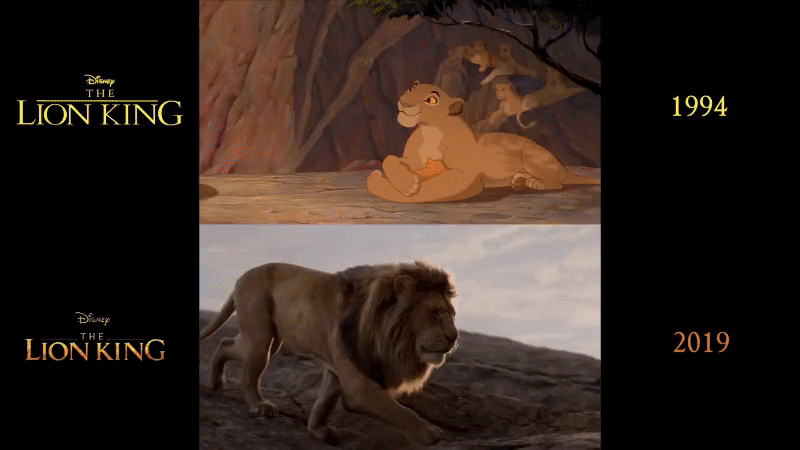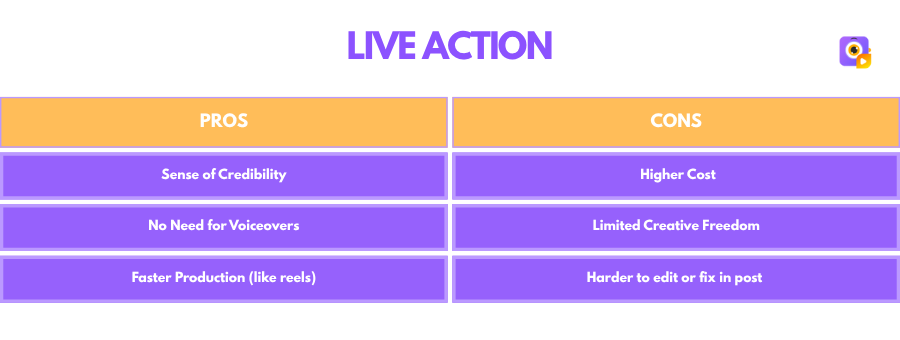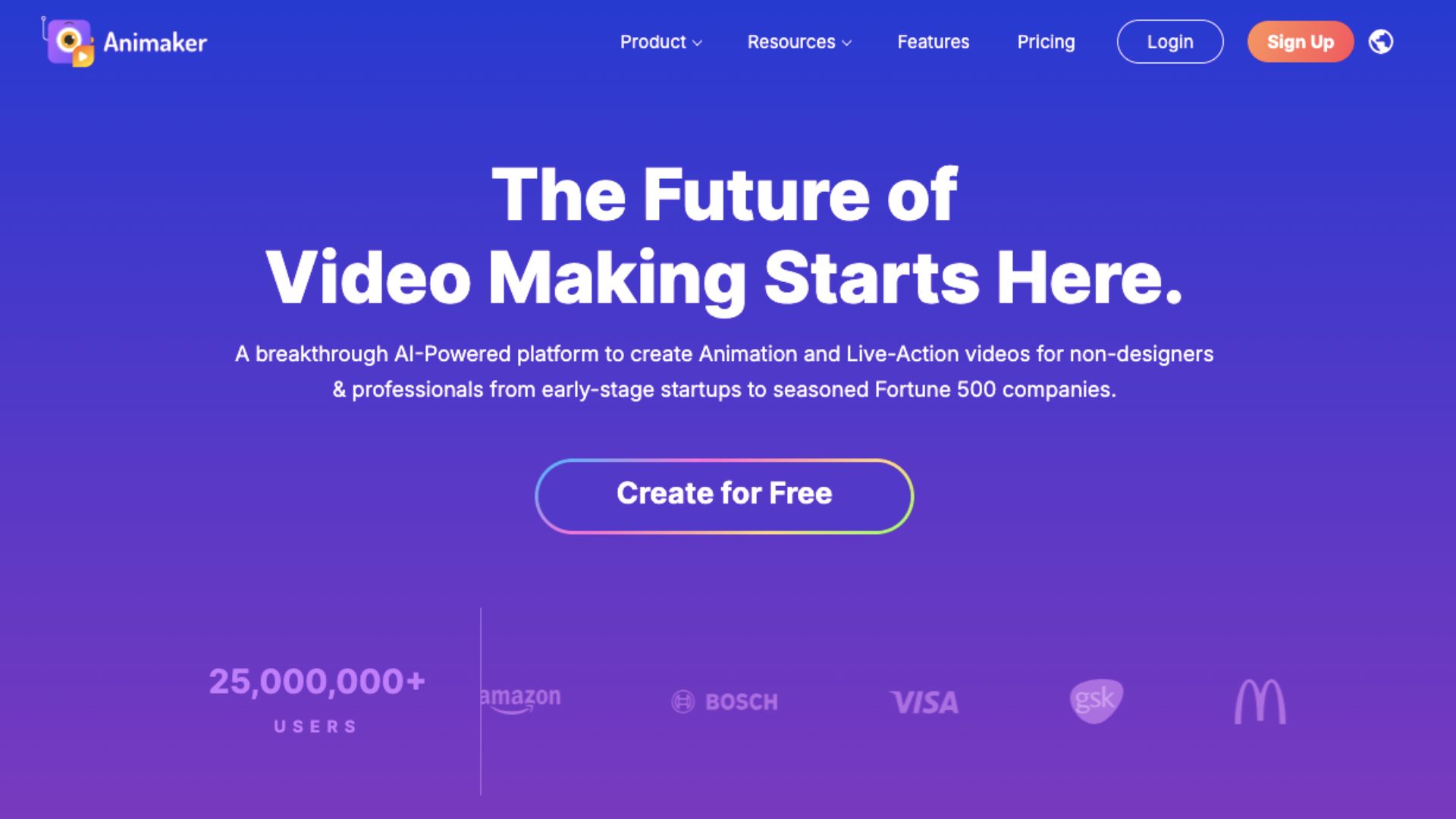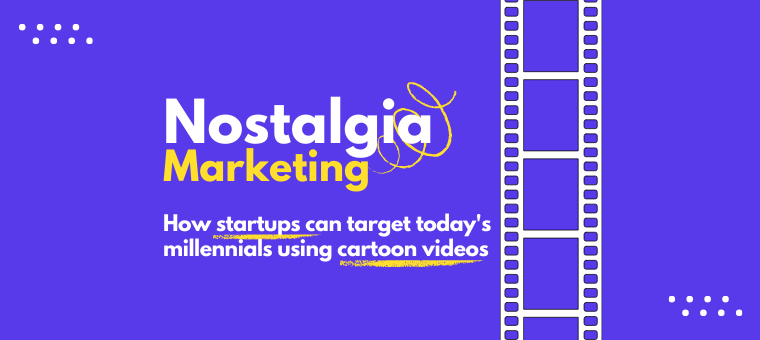Animation vs Live Action [Pros, Cons, Use Cases & Free Tools]
Remember the OG Lion King movie that we all grew up watching?
The one that had us all singing Hakuna Matata like it was a life philosophy?
Well, today’s generation got their own Lion King too - with a high-definition, live-action reboot.

Same lions. Same storyline. Two totally different ways to experience it.
The original animated version treated the movie with dreamy colors and exaggerated expressions, making every moment magical.
Meanwhile, in the live-action, those majestic lions have real-world textures, like rippling muscles and even faintly protruding ribs, that bring a raw, wild edge to the story.
And that’s the power of format.
The format you choose can completely shape the way it is seen, felt, and remembered.
It's also about the emotional experience you want your audience to have. And it starts with the first creative call -
Animation or live action?
Live action involves real people and elements, while animation is created through drawings, motion graphics, or 3D models.
Both can be wildly effective, and both can crash your computer if the file size is big enough.
But the real question isn’t which is better - it is which is better for your story.
In this article, we’ll break down the pros, cons, tools, and use cases of each format so you can choose your medium wisely.
- Animation vs Live Action - Pros & Cons
- Use Cases For The Two Formats
- Tools for Animation & Live Action
- Animation vs Live Action - Takeaway
Let’s get started with the pros and cons!
Animation vs Live Action - Pros & Cons

Animation Pros
1. Creative freedom - Animation isn’t bound by physics or logic. This means you can turn everything in your script a reality, no matter how imaginative it gets.
You can even create entirely new worlds with animation. [psst….like in the movie Avatar]
2. Easier to revise - No need for reshoots or calling the crew back. You can simply swap scenes, adjust visuals, or rework voiceovers right in your editor.
This is super handy if you’re working with tight schedules.
3. Custom Characters - Animated characters can become the face of your brand - memorable, relatable, and always on-message. [Think of Duolingo’s iconic green owl]
4. Easy to Repurpose - Once you’ve made an animated video, chopping it up for reels, stories, or presentations is so simple.
You can reuse the same assets across campaigns without shooting anything twice.
5. Budget-friendly (for certain use cases) - You don’t need sets, actors, or cameras. All you need is a good script and a powerful tool.
[bonus points if it’s AI-powered to speed things up]
6. Works Across Languages and Cultures - It’s way easier to localize animation for global audiences.
Many tools now let you switch text, swap voiceovers, and auto-sync lip movements with no need for manual editing.
Animation Cons
1. Steeper Learning Curve -
If you're working with 3D or frame-by-frame animation, it might take some time (and patience) to get the hang of it, or you might even need to bring in someone with technical skills.
2. Not Always Suitable for Serious Topics - Some stories just hit harder with real people.
If you're tackling a sensitive issue, animation might not deliver the same impact as live action.
3. Hardware or Rendering Demands - High-quality animations, especially 3D, can require powerful hardware and long rendering times.
This might not be ideal for smaller teams or tight deadlines.

Live Action Pros
1. Credibility - Live action brings a sense of authenticity that’s hard to replicate.
Seeing real people, real places, and real moments on camera builds trust fast, especially when the message is personal or unscripted.
2. Faster Production (in some cases) - With just a phone or DSLR and basic editing, you can shoot and publish live-action content within hours.
This would be ideal for social media trends or time-sensitive content.
3. No Need for Voiceovers - In live action, people can speak directly to the camera with a mic attached, with no need for separate voiceovers or lip-sync editing (unless it’s a movie or film project).
It keeps things simple and saves time in post-production.
Live Action Cons
1. Higher Cost - Live-action can get pricey, very quickly.
High-quality live-action productions often involve significant expenses for actors, crew, locations, equipment rental, permits, and catering.
2. Limited Creative Freedom - With this format, you can’t imagine making videos with flying pigs or talking pizzas.
Live action is grounded in reality and bounded by physics, and that limits how imaginative your video can be.
3. Harder to edit or fix in post - Changing scenes or elements usually means reshooting, which adds time and cost.
That’s where live action can get a bit less flexible.
And when you're working on a tight timeline or budget, that lack of flexibility can be a deal-breaker.
So, we’ve weighed the good, the tricky, and everything in between for both formats.
Still not sure which way to go?
Let’s make it easier by looking at when animation works best and when live action steals the show.
Use cases For The Two Formats
Even with a killer idea and script, it is important to choose the right format. So, let’s break down when you can use which!

When to use animation?
1. Explaining Complex Concepts
Animation works great at simplifying the complicated.
Think corporate training, onboarding, product demos, or medical explainers. If your message is complex, animation can help your audience understand and remember it better.
2. Storytelling
Storytelling and animation go hand-in-hand.
It’s a powerful way to tell your story in a fun, memorable way. And no, storytelling isn’t just for kids! It works for everything from brand narratives to educational content.
3. Limited Budget
Not all animation has to break the bank.
With plenty of cost-effective tools for both 2D (Animaker) and 3D (Blender), you can still create high-quality animations, even on a tight budget.
When to use live-action?
1. Building Human Connection
If your message needs warmth, authenticity, or real emotion, live action is the way to go.
It works great, especially if it is a customer testimonial, heartfelt campaigns, or a founder sharing their story.
2. Showcasing Real People or Places
Need to show off your team, workspace, or product in action?
Live action lets people see the real deal and builds trust by showing who and what’s behind the scenes.
Just like the video above, you can showcase your company's work culture in a fun way to attract new talent and create interest in joining your team.
3. You need a quick and simple setup
Simple ideas don’t need complex setups.
For short promos, team updates, or social media content, you can grab your phone or camera and start recording. You can then make use of online editors to make it look professional.
It’s fast, flexible, and great when you’re on a tight timeline.
Now that we have seen the use cases of both sides, you probably now have a better idea of what fits your story best.
Let’s dive into the tools that can help you get started or make the video creation process easier.
Tools for Animation & Live Action
Here’s a quick guide to popular tools for both animation and live action - whether you're DIY-ing it or building content at scale.
Animation tools
1. Animaker
An all-in-one, AI-powered platform that simplifies animated video creation, perfect for beginners and pros alike.

Users can build scenes from scratch or lean on Animaker AI to generate studio-quality animations from prompts complete with avatars, text, music, and more.
A quick look at Animaker’s long list of features includes -
- AI-powered text-to-animation
- Drag-and-drop editing interface
- Custom character builder
- Voiceovers with automatic lip-sync
- AI Subtitle Generation
- 100M+ stock assets
This platform is perfect for marketers, educators, and businesses that want professional-looking videos without design or animation skills.
2. Blender
A free, open-source 2D & 3D creation software that professionals use for animation, modeling, rigging, and even VFX.

This tool is perfect for advanced users or creative teams looking to build cinematic, custom animations with full creative control.
Note: It has a steep learning curve, but its powerful features make it one of the most capable tools.
3. Toon Boom
A professional-grade 2D animation software used in high-end TV and film productions.

Known for detailed rigging, advanced animation timelines, and built-in storyboarding, it is built for teams with complex needs.
This tool is best suited for experienced animators and teams working on frame-by-frame, character-driven storytelling.
Live Action tools
1. Animaker
Yes, again! Animaker isn’t just for animation. It’s also beginner-friendly for creating live-action videos using stock footage, uploaded clips, text overlays, and more.

It allows users to easily trim, stitch, and polish their footage without the need for complex software or editing expertise.
With built-in features like AI Subtitle Generation, seamless transitions, and the ability to mix animation with real footage, it is easy to make your video look polished.
Animaker is perfect for teams looking to enhance their footage or repurpose existing video content, without diving into pro-level tools.
2. Steve AI
Steve AI is an AI-powered live-action video creation platform that turns prompts and scripts into stock-based video stories instantly.

Apart from video creation, the tool’s built-in editing features include speed control, slow motion, reverse playback, and more, helping users fine-tune their video without needing a pro editor.
This tool is perfect for marketers and content creators who need quick, polished video output with minimal hands-on editing.
3. Adobe Premiere Pro
Adobe is the industry standard for live-action video editing, used by everyone from YouTubers to Hollywood editors.

It offers everything you need to polish a live-action video, from powerful timeline editor and audio mixing capabilities to advanced color grading tools and multi-cam editing.
This tool is perfect for editors who already have raw footage and want professional-grade control over how it is edited, styled, and delivered.
Animation vs Live Action - Takeaway
Animation & live action - They are both powerful in their own right. The key takeaway is knowing your story well enough to choose the format that brings it to life best.
- Choose animation when you need creative freedom, visual clarity, consistency at scale, or a budget-friendly solution using smart tools. Eg: Animaker 😉
- Go for live action when real faces, authentic emotion, or physical products and places matter most.
Know your story. Choose your format and use the right tools. That is the formula to create content that connects with your audience.



